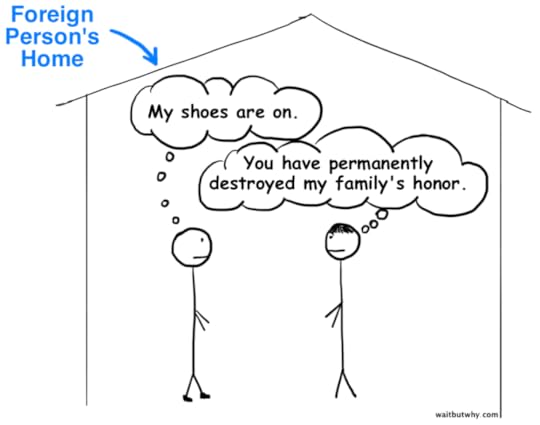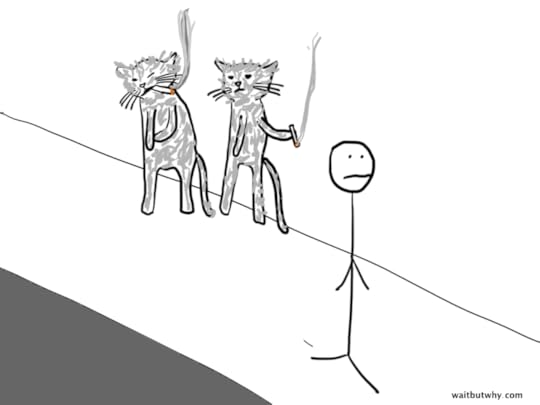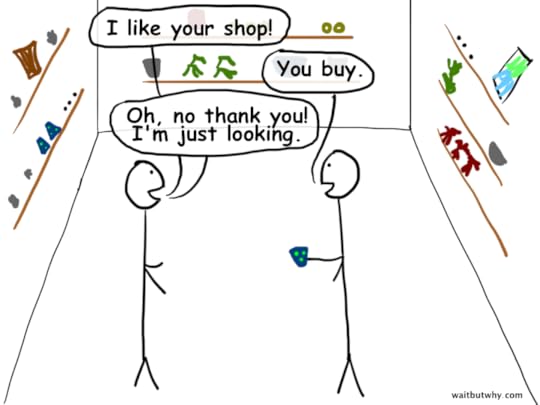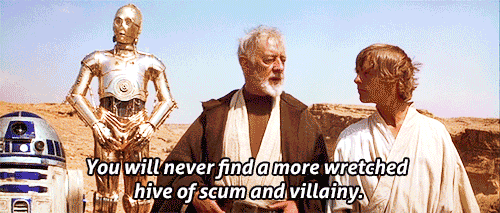Matador Network's Blog, page 2201
October 3, 2014
How Breaking Bad analogies can land you a travel filmmaking gig
Follow Matador on Vimeo
Follow Matador on YouTube
I AM NOT GOING TO LIE, I wasn’t overly excited about my latest job prospect of traditional balsamic vinegar making in Modena, Italy. I love balsamic in all its drizzled goodness, but it just seemed rather tame compared to some of my more recent job exploits overseas – tigers, elephants, and tuk-tuk racing filming. But damn Gina, I was sure wrong.
Somewhere between manning a Ferrari-made tractor and unleashing a flamer thrower on innocent vegetation, did I realize that 1) this Italian family of traditional balsamic makers was Steve McQueen cool, for letting a maniac loose on their estate, and 2) the amazing complexities behind unadulterated ‘tradizionale balsamico’ — versus the street grade stuff we typically buy in the supermarket — made for the perfect Breaking Bad metaphor. People just didn’t get the purity of the real stuff, so I was hell bent on filming a travel video parody using my favorite tv show to bring home that message.
I am still not quite sure how I convinced an Italian family that filming a parody about traditional balsamic was a good idea for a promotional travel video. They had never seen the show, and my feeble explanation comparing the process to an episode of Breaking Bad — how the cooking of methamphetamine by chemist Walter White was just like cooking their ‘pure stuff’ Tradizionale Balsamico di Modena — must have sounded like some crazy bullshit an Italian politician would spit out while trying to get away with whatever shenanigans he was embroiled in that week. Nonetheless they were cool with the idea, and before I knew it, I was deep in the process of making a very awesome, untraditional travel movie. 

12 signs your girlfriend is Mexican

Photo: Jose Francisco Del Valle Mojica
Hacé clic para leer este artículo en español. Tambien podés darnos un “me gusta” en Facebook!
You have been a victim of the infamous “pancho.”
Pancho refers to that awful situation (so typical in couples) where irrationality takes over and everything goes to hell. Getting out of the car in the middle of nowhere, tearing photographs, making a scene, the cold shoulder… burning down the house. It’s all the same thing: panchos. And yes, Mexican girls love panchos.
You’re constantly pressured to join the Telenovela fandom.
There is a cancer in Mexican society and it is called Telenovela. We are totally surrounded by this evilness and it’s quite easy to become addicted if we’re not cautious. If your girlfriend has this evil inside her, don’t get overconfident or you’ll get infected too and your personal ambitions will become as vain as staying home on a friday night because you’re so hooked on María la del Barrio and its never-ending cliffhangers.
You are getting used to your new relationship…with all of her family.
Since you met her family for the first time, they started calling you mijito, they asked you everything there is to know about your life and you met more relatives than you can actually recall. Chances are they were doing all these introductions while you were chopping some onions to help with dinner preparations. If her family lives near you, it’s quite probable that you’ll end up at her place for the next Christmas, Day of the Dead, Independence Day, New Year’s Eve, Día de Reyes, Easter, Mother’s Day — welcome to your new grand family!
You live in constant fear of her jealousy.
Your ex is your new best friend? Not anymore! Sometimes you get a ride from that pretty neighbour of yours? Forget it! This is how it’s gonna be if you want to live in peace and happiness, especially when you’re starting a relationship and insecurities abound. Mexicans are the jealous type, but since we’re all the same, we hardly notice it. That said, if you ever run into a girl that manifestly admits to be VERY jealous…get the hell out of there.
You know a “family gathering” means the WHOLE family and probably some neighbors too.
If you’re thinking about dinner with her folks, be prepared for a surprise. Mexican families are large and they get together at every opportunity. Keep in mind that important events can gather family members from the farthest regions of the world as well as every single Mexican in the immediate surroundings. A good example of these gatherings is the Boda de pueblo, a traditional marriage that lasts three days and brings half the town together for a celebration you’ll never forget.
Your waistline has grown since starting this relationship.
Your new family never gets tired of feeding you. They’re not planning to feast on you for Christmas or anything that macabre, it’s just that in Mexican culture, food is the perfect excuse for socializing. Food, drinks, and more food will keep coming while you participate in long conversations around the table. Mexicans also have a habit of stopping for tacos after a night of partying…and that’s a habit you can get used to.
You know that “I’ll meet you there” is not an option.
Mexicans have a set of unwritten rules regarding courtship. Ladies and gentlemen’s roles are partially determined by the legacy of machismo we inherited from old Mexican traditions. Some of these rules have found their way into modern society and can determine how your girlfriend expects you to behave toward her. One of these conducts is especially widespread and ignoring it can result in incomprehensible panchos: your Mexican girlfriend expects you to pick her up at her home, regardless of plans, geography, traffic, or convenience, always!
Your new family is all up in your personal life.
When marriage and kids come into conversation, there will always be a nosey aunt that puts you and your girlfriend on the spotlight by asking “When are you gonna surprise us?” Go ahead…defend yourselves.
You’ve memorized her favorite songs even though you don’t like them.
You’ll surely learn some Spanish lyrics based on your girlfriend’s preferences. Luis Miguel, Vicente Fernández, Timbiriche, La Banda el Recodo, and even Maná are all common options. The things you do for love!
You’ve learned that simple details are the most appreciated.
The best present for your girlfriend is not necessarily the most expensive or luxurious, but the one that demonstrates that you invested time and effort in something that is both personal and a reminder of the special things you share. If you’re far away from Mexico, you don’t need to spend a fortune taking her to dinner in the fanciest restaurant for her birthday; way better if you can get hold of a some Chocolate Abuelita, Pulparindos and Miguelitos.
You look extremely happy!
You have a mexican girlfriend — what else could you ask for? 

8 Third World travel experiences
In Third World countries1, you can often kind of just walk into places and drive in the wrong lane and drink on the street and do whatever you want and no one cares. On some domestic flights in Myanmar, there wasn’t even a security checkpoint.
On the other hand… The same lack of structure can make travel a logistical nightmare.

All illustrations courtesy of the author
2. If you’re friendly, it’s not hard to get to know local people.
I acknowledge that I might think this is true because I just act friendlier in the first place because I think people in other countries are friendlier and then they respond in kind. Either way, I’ve been invited into dozens of homes in Third World countries simply by being smiley and starting a conversation. One time, a family in a tiny apartment all slept in the kitchen to give me their one bedroom (against my pleading protests). I’m yet to be invited anywhere by a New York stranger.
On the other hand… The language barrier can ruin everything if you don’t learn some phrases from the country you’re traveling in.
3. The food is often great and totally different than what you’re used to.
On the other hand… The food can be terrifying.
4. The culture is usually completely foreign to you and eye-opening and fascinating to learn about.
The way I like thinking about it, I live in a world that is a product of centuries of a certain population of humans and the way they learned how to live life. When I travel to any really different culture, it’s a chance to see what a totally different population of humans ended up with when they took their own crack at how to live life. What could be more fascinating than that?
On the other hand… You might inadvertently horribly violate some cultural taboo.
5. There are cool animals.
I seem to come across elephants, (sedated) tigers, cobras, emus, and a number of monkeys and apes in Third World places. Not much chance to do that where I’m from.
On the other hand… There are lots of stressful stray animals everywhere.
6. You can buy amazing crafts you can’t get anywhere else.
On the other hand… You’re the target prey for relentless shop owners.
7. It’ll remind you that you live in a palace back home, and that you did nothing to deserve that.
All it takes is a little time in a Third World country to be blown away when you return home by the sheer quality of life you get to enjoy — the pristine cleanliness of the streets, the vast abundance of food in the grocery stores, the utter comfort of everything — suddenly the immense wealth of the First World is blatantly apparent everywhere you look and you remember that everyone you know lives like a king without realizing it. Then two days later you forget too and start complaining about everything again.
On the other hand… It’ll remind you that you live in a palace back home, and that you did nothing to deserve that.
8. You won’t be one of the ignorant First Worlders who thinks it’s dangerous to visit the Third World or has other gross misconceptions of what Third World countries are like.
If you employ the same common sense that keeps you safe in your hometown, visiting Third World countries is zero percent dangerous. And anyone who tells you differently is either way too paranoid or has little travel experience.
On the other hand… You risk becoming a self-righteous douchebag who’s way too proud of themselves for their Third World experiences.
1There’s a chance that the terms First World and Third World are offensive. I’m not sure. I googled around about this, and my impression is that there are like two more years before the terms become officially offensive — so I plan to get my fill while I can, because the terms Developed World and Developing World are far less amusing. These terms originated during the Cold War, when the countries aligned with the US and capitalism were called the First World and the countries aligned with the Soviet Bloc and communism were called the Second World. The non-aligned countries were the Third World, and since that time, the terms First and Third World have taken on the new meanings of Developed and Developing nations.
This post was originally published at Wait but Why and is reprinted here with permission. Wait But Why posts every Tuesday. To receive Wait But Why posts via email, click here. Or you can visit their homepage, pop into Facebook, or connect via Twitter.

20 signs you're a newbie traveler

Photo: Pedro Ribeiro Simões
EVERY WORLD-WEARY, UBER-EXPERIENCED TRAVELER has, at some point, been a total noob. It’s a lot of fun to be a travel noob, actually, because you get to look at the world with fresh-eyed wonder and not with wariness and suspicion. That said, you’re probably going to make a complete ass of yourself.
Here are some of the signs that this is your first time away from home.
1. You think of using squat toilets as a “cultural experience.”
You’ll say stuff like, “At home, there’s no such thing as poop hang time!” and “I got the strongest thighs while I was abroad.” You will not mention what you had to use when you realized your Indian bathroom didn’t have toilet paper.
2. You tell the locals you like their “accents.”
Someday soon, someone will tell you with irritation that, when you’re in a different country you’re the one with the accent, and you’ll never say it again.
3. Someone mentions shower sandals at the hostel, and you’re totally confused as to why you’d wear sandals in the shower.
A few days later, when you’re playing host to the greatest ever ringworm empire, you’ll be scouring the city at the expense of travel time in search of just one cheap pair of flip flops.
4. You don’t pack Pepto-Bismol.
Also, you’ve never had to mime diarrhea to a pharmacist.
5. You don’t even try to bargain down the market prices.
They’re already so low anyway! Eventually, a fellow tourist — or in my case, the shopkeeper I was at that very moment buying from — will tell you, “Yeah, that’s not the way it works. You’re supposed to haggle.”
6. No smell has yet haunted your dreams.
Ah, to be young, carefree, and to have never before smelled durian fruit, rotting shark meat, or the Ganges River.
7. You think Lonely Planet is the key to finding the hidden, out-of-the-way tourist spots.
Then you get to the “off-the-beaten-path” pisco bar and wonder why there are so many gringos around.
8. In the planning stages, you don’t once think about the weather in the country you’re visiting.
You get there and ask, “What’s a rainy season? Isn’t it just winter, spring, summer, and fall?”
9. You have yet to divide your friends into “regular friends” and “travel friends.”
You’ll never make this mistake again, so long as the “regular friend” you made the mistake of traveling with doesn’t kill you or get you killed.
10. You buy a postage stamp / bottle opener / shot glass from whatever place you’re visiting.
You think, “I’ll get one of these for every place I visit, and at the end of my life, I’ll have that as documentation of my travels!” Eventually, though, you’ll either change what you want to collect, or forget to buy the item once and then never do it again.
11. In the airport security line, your laptop remains in its bag and your shoes remain on your feet long enough to stress out the travelers behind you.
12. You take pictures of your every meal.
13. You take pictures of you and your fellow travelers all jumping at once in front of [insert famous local landmark here].
14. You take a picture of yourself holding up the Leaning Tower of Pisa.
Or placing your finger on top of the Eiffel Tower. Or kissing the Sphinx. And God help you if you took a picture making the Washington Monument look like your dick.
15. You’re fully expecting to meet a sexy local abroad who you’ll have a torrid but brief love affair with.
Actually, there’s a pretty solid chance this one will come true. But still, the fact that you’re expecting it makes you a noob.
16. Your itinerary doesn’t leave any buffer time for late trains and grounded planes.
The exception to this rule is if you’re going to Japan, in which case it’s totally reasonable to expect their trains to run like clockwork.
17. You can’t wait to see Times Square.
First time in New York: “Hey! Look at all the pretty lights!”
Second time in New York:
18. You think you can match the English / Irish / Scottish / Australians drink for drink.
Aww. How cute.
19. You just pack one book.
“32 hours on a plane and 18 on a train? Of course I won’t finish this Twilight book in that much time.”
20. You think, as you pull back into your driveway, “Well, that should quench that wanderlust for a little while.”
Oh, you poor thing. 

October 2, 2014
Danny Macaskill: The Ridge [vid]
Follow Matador on Vimeo
Follow Matador on YouTube
DANNY MACASKILL IS AT IT AGAIN. In his first mountain biking film back home on the Isle of Skye in Scotland, Macaskill takes a death-defying ride along the notorious Cuillin Ridgeline. One of Britain’s most epic mountaineering challenges, this is a path that’s never before been ridden on a full suspension mountain bike.
Watch the film, it’s unreal. Then, in the words of Danny, “Go ride your bikes in the hills.”
#TheRidge is the brand new film by Danny Macaskill and Cut Media. 

How to piss off Greenlanders

Photo: Destination Arctic Circle
Ask us if anyone actually lives here.
Um, the short answer is yes. We have a population of 57,000. Yes, the whole population. The capital city, Nuuk, has about 16,000 people — this is where I grew up. Greenland is small but far from last place when it comes to countries ranked by population.
A few that come after us: the Faroe Islands, Palau, Vatican City, and dead last, the tiny South Pacific post-Bounty-mutiny nation of the Pitcairn Islands (population: 56). A few that come before us: everybody else.
Accuse us of hunting helpless baby seals.
We’ve hunted our own food since the beginning of time in our huge, magnificent outdoors where animals live free and not in cages pumped full of chemicals. So don’t start in on us about how cute the seals, reindeer, and whales are. We don’t just live in Greenland — we survive in Greenland. So we make damn good use of the meat, fat, and skin every single time.
And we don’t hunt baby seals — that would’t feed enough people and would destabilize the population. A whale, on the other hand, can feed an entire community for a winter. And it goes beyond feeding — the fat is used as oil, the skin and organs are harvested, and there’s wax to be had as well. Everything is used. Can you say that about the last steak you ate? Could you even say where it came from? Or how about that tuna sashimi you had last week? Did you know it’s being fished to near extinction? Our tradition of sustainably living off our land — and its wildlife — would never result in a species extinction. But more than that, remember how we only have 57,000 people?
Call us Eskimos.
The most common description for my kind, and other Arctic-dwelling peoples, is “Eskimo” — and, boy, do we hate it. Unless you’re from Canada or Alaska you might not know the term “Inuit,” but it’s the correct and proper term to use. To us, Eskimo is a word for cartoons and stereotypes; it’s outdated and a bit insulting because it’s a generalization. Some Inuit might even consider it a slur. The word Eskimo comes from Alaska, perhaps from a native word that means “people who eat raw meat.” It might fly in Alaska (and it might not), but the bottom line is it’s not cool in Greenland.
In reality, most Arctic natives from North America, Greenland, and Chukotka, Russia prefer the term Inuit — and certainly prefer it above eskimo; while the northern parts of Norway, Sweden, Finland, and the Kola Peninsula of Russia tend to prefer the term Saami. There are even more tribes and more terms because not all natives have the same roots, traditions, or cultures — despite outsiders wanting to paint us all with the same brush.
“Konnichiwa!” (i.e., greet us in an Asian language).
I realize to some people we look Asian, but don’t assume we are. Yes, I have smaller eyes and very wide, large cheekbones that are common to ethnic Greenlandic — and yes, there are theories about who crossed what continents to populate these arctic places, but that’s not the point. The point is: at least have the courtesy to ask where I’m from instead of blurting out “Are you from China?” It’s a naive assumption, especially considering we’re literally on the other side of the planet from Asia.
Assume we live in igloos.
As “the people” of the arctic, a lot of outsiders assume we dwell in igloos. This comes from the same cartoons, or commercials, or old movies that people get the word Eskimo from. No, we don’t. We live in houses. Igloos are for fun in wintertime when we build them with our cousins, siblings, or nieces and nephews, just as you might build a snowman. I never heard of anyone actually living in one here in Greenland. In places like Alaska and Northern Canada, sometimes Arctic hunters build one for shelter from storms or when out on long hunts. Wouldn’t you?
Tell us how you heard we all get around by dogsled.
As other countries, we have roads. And we went and got cars to fill those roads. We have seasons — believe it or not — and that means we don’t have snow year-round in many parts of the country. What we do have are Greenlandic Dogs. Not huskies, like in Alaska, but Greenlandic Dogs. These dogs are aggressive and only loyal to their owners, and we are told many times as kids to never get close to one that we don’t own. People are only allowed to own Greenlandic Dogs starting in Sisimiut — a town somewhat in the middle of Greenland — and every city, town, and village north of it. Even at this halfway point, dogsleds are mostly used to travel away from the city and go hunting.
Make fun of the language.
We are proud of being Greenlandic, very proud. We have a language that is only similar to Inuktitut in Canada. English, Danish, Spanish, and many other languages like to make sentences out of lots of small words. Well, in Greenlandic, we add letters to the end of the word and make one long word instead of a sentence. For example: “I am going traveling for a little bit”: Angalaalaalerpunga. One word, but a whole sentence/statement. Angalaa (travel) laa (little bit) lerpunga (I am going). Make fun of it all you want, but we are proud of our unique linguistics, which sounds like music to my ears.
Say we’re Danish.
No — we’re Greenlandic. And only Greenlandic. We’re reminded repeatedly that Denmark “owns” us. Denmark is 3,645km from our capital, Nuuk, and has a completely different culture, language, and landscape. For centuries, Greenland was inhabited by Inuit, but explorers came knocking, and Denmark was the first one to offer their help in developing our country. Sure, they colonized us, but that didn’t dilute our Greenlandic identity. Also, that was in 1814, which was over 200 years ago! 

Tourists vs. locals in San Francisco

Photo: Thomas Hawk
1. Tourists complain about the fog. Locals: parking.
Everyone complains about the hills.
2. Tourists take selfies on the Golden Gate Bridge. Locals: bikes.
The Golden Gate Bridge is an Instagram hot spot. Captions usually include “#somuchfog” and “#loveSanFran.” But for bike-loving locals (of which there are many), the bridge is the main transportation artery leading to the wondrous routes of the Headlands and Marin County.
3. Tourists call it “San Fran.” Locals: The City.
Who needs NYC or LA when your home base is San Francisco.
4. Tourists conquer Lombard Street. Locals: Lands End.
Locals avoid Lombard like the plague. While tourists walk or, god forbid, attempt to drive the meandering street, locals can be found hiking Lands End, the coastal trail that proves San Francisco is the ideal mix of nature and urban landscape.
5. Tourists treat the Haight like a historical time warp. Locals: home.
Haight Street and its surrounding area is one of those rare places where tourism and functionality converge. The neighborhood has become a popular spot for young urbanites to live, while still maintaining the historic counterculture it’s known for. We’ll see how long this duality lasts though…
6. Tourists go out in the Marina. Locals: Polk.
True, there are plenty of locals milling about Stock and Trade on a Saturday night, but these are mostly of the finance-bro variety. The area particularly tends to attract visiting European men.
7. Tourists spend their Saturdays at Fisherman’s Wharf. Locals: Dolores Park.
Why watch the seals at the wharf when you can people watch during a picnic at Dolores Park?
8. Tourists ferry out to Alcatraz. Locals: Angel Island.
Don’t get me wrong, every San Franciscan has stepped inside the bone-chilling cells at Alcatraz. But most locals would rather ferry out to Angel Island for a weekend of camping.
9. Tourists take cable cars. Locals: Muni.
Though Uber and Lyft are gradually taking over as the main mode of transit, at least among local 20-somethings. 

10 signs your boyfriend is Russian

Photo: Evgeni Zotov
1. “Going back to his place” means you’re headed to either a decrepit dormitory, or his parents’ house.
Since most Russian students do not have the financial resources to live on their own, many opt to live in their university’s ramshackle, isolated dormitories. Think one hour outside of the city center by metro, followed by a 20-minute bus ride.
Inside the barely standing building, a gruff security guard will seize your passport before you climb five flights of stairs to your boyfriend’s lair. There, you will find no less than five other students residing in a three-person room. At least one of these cohabitants will be shirtless, and will join you and your guy for a cup of tea before “going to the store.”
Overnight guests are strictly forbidden by security, but don’t worry — that’s nothing a bottle of whiskey can’t fix.
If your man has already graduated and has a good job, chances are he still lives with his parents — and possibly grandparents. So after that romantic dinner, get ready to say “Good evening!” to granny, who will force-feed you sausages until you awkwardly retreat to your boyfriend’s childhood bedroom.
2. After a month of dating, you already know his mother and grandmother.
Even if he left his family back in Siberia, these overprotective matrons will find an excuse to visit Moscow as soon as you enter the picture. While your boyfriend is in the bathroom, they will explode with praise for their perfect progeny:
Ivanushka scored all A’s in his university exams!
His arms are strong like tree trunks!
He doesn’t drink! (That’s a lie.)
Oh, how wonderful it would be for Ivanushka to settle down with a beautiful wife like you!
But you never really figure out what Ivanushka thinks about the whole situation.
3. You’re either the love of his life, or you’re nobody.
While Russians may appear cold and harsh to outsiders, beneath the frozen shell of every Slav lies a true romantic. Once a Russian man has fallen in love, he may never get back up. Many still treasure the notion of finding their “one true love” and settling down as soon as possible. If you are a foreigner who is only visiting Russia for a limited period of time, your boyfriend may either implore you to stay (and marry him), or, conversely, cut you off completely because he “can’t withstand the pain.” Someone’s been reading a little too much Dostoevsky.
4. While you’re walking, he prefers you to latch onto his arm instead of holding hands.
It’s -15C, the icy sidewalks haven’t been cleaned since the Brezhnev era, and you are both wearing thick insulated gloves. Holding hands just doesn’t work; a better way to stabilize yourself against a potential slip is to hold onto the trunk-like arm of you gallant russkiy.
5. He will always pay for everything in its entirety, even if you have more money than him.
In Russia, being female supersedes one’s status of being a foreigner wealthy enough to travel abroad. So what if he had to beg his single mother for 1,000 rubles to woo you at a fancy coffee house? Chances are, the lady was so thrilled to see her son go on a date that she was more than willing to sacrifice her last rubles for the promise of grandchildren.
6. Valentine’s Day will come and go; International Women’s Day and Defender of the Fatherland Day are where it’s at.
Although Valentine’s Day has gained momentum in Russia as a commercial holiday, the real dates of importance for citizens throughout the post-Soviet space are March 8th, and February 23rd. On March 8th, International Women’s Day, workers and students enjoy the day off, get to watch television specials, and your beloved will shower you with overpriced roses and chocolates.
In return, on February 23rd, Defender of the Fatherland Day, you are expected to treat him to something nice. Although the holiday was originally created to honor members of the Russian Armed Forces, it is now accepted as a day to celebrate all men.
7. When you’re getting drunk, he will buy you special “girl” drinks.
For all of its alcohol-centric culture, there remains a surprising taboo surrounding women’s drinking habits. Some believe that “cultured” women do not drink vodka (outside of celebrations), or even ordinary beer. Thus, do not be surprised if your Stoli-chugging beau offers to buy you champagne, Redd’s (a sweet cider-like ale), or perhaps a 40 oz. can of “Sex on the Beach.” You know, classy stuff.
8. You are forbidden from swearing in Russian.
Admittedly, the system of Russian cursing (mat) is far more vulgar and complex than its English counterpart, involving curious grammatical adaptations and a heavy dose of prison jargon. As such, many “cultured” or “educated” men prefer that their women do not curse, even if their own mouths are dirtier than a dormitory’s toilets. That said, they are probably doing you a favor, since learning mat is akin to assimilating a completely new dialect of Russian.
9. The government’s military draft is an omnipresent threat to your relationship, and to your boyfriend’s life in general.
All healthy men in Russia between the ages of 18 and 27 who are not enrolled in higher education and who are not caring for children or relatives are required to complete one year of military service (a reduction from the previous term of 18 months). Men will go to great lengths to avoid this miserly fate, often bribing doctors for medical exemptions. If your boyfriend seems especially concerned about his university exams, it is probably because he knows that if he flunks out of school, he will be sent straight to the barracks.
10. He will go ridiculously out of his way to see you home to your doorstep.
Even if he lives on the other side of the city and it’s 11:59pm in the middle of a blizzard, rest assured that your Russian boyfriend will escort you to your doorstep after a boozy evening out. Afterwards, he will sprint to catch the last metro train of the night, where he will sit silently among the tired faces and forgotten bouquets. Say what you will about Russia, but in a land where so many people struggle to live normally, it is a miracle that chivalry is not dead. 

22 iPhone tricks for travelers

Photo: Jorge Quinteros
1. Use “burst mode” to capture every moment.
On the road, you only have one chance to capture a genuine moment — and you don’t want to blow it. Enter burst mode. While using the camera, simply hold down the shutter button (as opposed to tapping it once). A counter will come up, showing you how many photos you’ve taken. And you can take hundreds, considering the iPhone’s sensor and image signal processor allow it to take 10 photos per second. Beats trying to get an elephant to do the same pose again so you can get the shot.
2. Format text for those on-the-go business emails.
If you’re frequently on the run and operate a business of any sort, you may need to send out an email or two. And we often need to say something with emphasis. Fortunately, it’s pretty easy to italicize and bold email text. In the body of your email, “select” the particular word or phrase you’d like to format, and click the small arrow when the popup dialog comes up. Press the “BIU” button and choose whether you’d like to bold, italicize, or underline your selection. Done.
3. Get the right picture by switching the direction of your panoramic photo.
While using the iPhone camera’s “Pano” function, you typically have to move your camera from left to right as you take your panoramic photo. But this doesn’t always make for the best-framed photos, as you might not get the exact shot you desired due to the “start” and “end” points. But that’s an easy fix. Click the large arrow, allowing you to take a photo starting from the right instead. Now you won’t end up cutting out the most important part of your picture by accident.
4. Save battery life.
When your battery’s low and you’re in an unfamiliar location, you may want a little bit of juice in reserve in the event you need your phone for an emergency. There’s a laundry list of ways to do so:
Turn LTE off.
Turn Bluetooth off.
Choose a background that’s not “dynamic.”
Turn wifi off.
Disable “Background App Refresh.”
Dim your screen brightness.
Turn off “Location Services.”
And there are many more. Or you can just turn your phone off for a bit. Yeah, do that.
5. Recharge your battery faster using airplane mode.
When you’re in a rush and low on battery, set your phone to airplane mode before allowing it to charge. This turns off all wifi and cellular signals, preventing it from sucking up unnecessary power while it charges. Oh, and make sure you use a wall charger. It’s much faster than your PC’s USB port. Lastly, try not to play Candy Crush while charging your phone. It doesn’t help.

More like this: 10 tips to shoot better photos on your phone
6. Get a detailed calendar so you know what you’re doing and when you’re doing it.
This one’s quick and simple. When viewing your calendar in its typical form, you need to click a particular date to see the hour-by-hour itinerary. But if you turn your phone to landscape, you’ll get the hourly play-by-play for each day without having to click a single button, allowing you to view and edit your travel schedule with ease.
7. Lock focus and exposure during photos for the right light.
You’ve likely activated this camera function by accident before, and weren’t really sure exactly how you did it (or what it does). In order to lock the focus and exposure of a particular shot, simply hold your finger down on your desired on-screen focal point. A yellow “AE/AF Lock” banner will pop up on-screen, signaling that you’ve locked the auto-exposure and auto-focus. This will remain until you’ve taken your photo (or you can click the screen again to remove it).
8. Use the “Near Me” feature in the App Store for a local’s point of view.
Another easy one. Simply open the App Store and click the button that says “Near Me” in order to see the apps that are popular in your current location. This might lead you, for example, to the app Muni Watch when you’re in San Francisco (which allows users to track city buses in real time). It’s worth a look wherever you go — you never know what you’ll find.
9. Turn off parallax if you get motion sickness.
For those who experience motion sickness, there’s an option that allows you to turn off some of the phone’s functions that may cause it (namely, the parallax effect, which makes the icons on the home screen appear to float as your phone moves). In your “Settings,” visit “General->Accessibility” and scroll down to “Reduce Motion.” Turn the function on to disable the effects. Now you don’t need to blame your phone for having to carry Dramamine everywhere you go.
10. Save your map for offline use when you’re overseas.
If you’re overseas, it’s unlikely you’ll be using cellular data frequently, but you’ll probably need to access your maps. The solution? Save them for offline use. While using Google Maps, locate your target area. Now, type “ok maps” in the search bar. You’ll be prompted to save the map for offline use. To access it in the future, simply click the person icon next to the bar. The rest is self-explanatory. Just remember — try this one while you do have Internet access. Oh, and the map will only be saved for 30 days before you have to create it again.
11. Shake to undo while writing an email or text.
If you’re typing out an email or text message and make a spelling error, your typical response is likely to click on the screen or go back and delete it — but why bother? Shake your phone to prompt you to “undo” the last action. And if you’d rather not undo, shake it again to “redo.” Not a huge time-saver, but it’s convenient. Besides, shaking things is fun.
12. Use the volume buttons to snap photos and prevent blur.
Taking a photo by clicking on the phone’s screen often causes camera shake and blurry photos. After all, you’re tapping your finger on something you’re trying to keep balanced. But there’s a solution, and it’s one of the more widely known iPhone tricks. You can simply use either the up or down volume button to take the photo (helping you keep the phone stable). And if you want to use burst mode, you can. Just hold the button down.
13. Restrict cellular data access to save your phone bill.
If you leave your cellular data on while traveling, you can save your phone bill (to an extent) but restricting specific apps to wifi only. Just open “Settings,” tap “Cellular,” and scroll down. You’ll see a list of apps under “Use Cellular Data For.” All that’s left to do is uncheck the ones you’d rather only use on wifi (hopefully most of them). If you’d rather make sure your phone bill doesn’t fluctuate at all, just leave your phone on airplane mode.
14. Invert colors for those overnight trips.
This one’s helpful for those South American / Southeast Asian sleeper buses. Head to “General->Accessibility” via “Settings” and you’ll see the “Invert Colors” function. While at first it just seems to make everything look funky, it’s helpful for low-light scenarios. The white text and dark backgrounds reduce glare and brightness (ideal for those times when your eyes are sensitive to a lot of light). You’ve probably picked your iPhone up in the middle of the night, only to be nearly blinded by the display. This helps.
15. Save a credit card for on-the-go purchases.
One of iOS7’s features is the ability to save a credit card for future use while using Safari, making it easy to buy bus tickets (and anything else you may need) without having to whip your credit card out in public. Open “Settings,” tap “Safari,” tap “Passwords & Autofill,” and turn on “Credit Cards.” Set up your passcode lock, and add a credit card.
16. Check your “frequent locations” to find that awesome bar again.
Remember that controversy about the iPhone tracking everywhere you go? Turns out that feature can be useful sometimes. In the event you’re visiting somewhere that you’re still able to use cellular data, you’re in luck. Follow the path of “Settings->Privacy->Location Services->System Services->Frequent Locations.” It’ll show you the locations you’ve visited recently and/or frequently on a map, allowing you to figure out exactly where that awesome dinner spot you came across the other night actually is.
17. Make Touch ID more effective for a quick log-in.
Have you found your phone’s Touch ID function often not recognizing your fingerprint? If seeing “Try again” makes you want to throw your phone at the wall, take a deep breath. Head to “Touch ID & Passcode” in “Settings.” You’ll notice there are actually four slots available for fingerprints. For the first, use your dominant hand’s thumb pad. For the second, use the tip of your dominant hand’s thumb pad. This accounts for most ways you’ll place your hand on the sensor. For the final two slots, repeat with your other thumb. Now it’s unlikely you’ll need to use the passcode to log-in anymore. With either hand.
18. Keep the compass on track so you don’t get lost.
Hopefully you’ll never need to use your iPhone compass — but in the event you do, the phone has a simple feature that helps you stay on track. Once you’re headed in the right direction, simply tap on the compass. By doing so, it “locks” a direction — if you deviate from said direction, a red bar will fill up around the compass, showing you how far you’ve moved away from your original path. Do the right thing. Stay on course and say no to red bars.
19. Turn off “noise cancellation.” Or turn it back on. Your pick.
Unknown to many people, the iPhone utilizes a noise cancellation feature while you’re on the phone. It works by “listening” to ambient noises and creating another “audio track” that cancels out said noises. This effect often creates an uncomfortable in-ear sensation for a lot of people. If you find yourself not feeling well when using the phone on occasion, give this a shot. Tap “Accessibility” via “Settings->General” and swipe “Phone Noise Cancelation” off. If it doesn’t help, just swipe it back on.
20. Use the “hidden” accent marks to help you spell foreign words.
If you need to spell foreign words, which are often covered in accent marks (Vietnamese, anyone?), this tip’s for you. While typing using the iPhone’s keyboard, just hold a particular letter down in order to see the related accent mark options. It’s quick, easy, and definitely beats omitting an accent mark and accidentally saying the wrong word in the process.
21. Keep your data almost “too safe” while you’re on the move.
While you may hope to never lose your phone, these things happen. In the event it does, it’s important that you have everything secured. This can be done in a series of steps. First, switch to an alphanumeric passcode (Settings->General->Touch ID & Passcode->Turn off Simple Passcode). Next, turn off access to the Control Center and Siri via the Lock Screen (Settings->Control Center->Turn off Access on Lock Screen), (General->Touch ID & Passcode->Turn off Siri). Now go ahead and activate Find My iPhone, and you’ll be good to go in the event you need to remotely wipe your phone if you lose it.
22. Search for terms on a webpage if you need information quickly.
Say you’re in a rush looking for a foreign phrase on a webpage of encyclopedic length. Scrolling through a thousand words in a different language isn’t exactly your best option. Many people have probably come across the solution but overlooked it. Just search for the term instead. While visiting the webpage you’d like to search via Safari, simply click on the address bar above once again. Type the particular term you want to find. Beneath “Google Search” and “Bookmarks and History,” you’ll see “On This Page (N matches).” You’re there — click “Find (term)” to highlight all instances of the term you’re looking for. Simple. 

Going to Australia on a work visa

Photo: Scott Sanders
1. Befriend more Germans, Brits, and Canadians than Australians
One of the hazards of living and working with mostly foreigners is that you know hardly any Australians. You may celebrate Canada Day and be able to say key phrases in German, but never discussed Tony Abbott’s many embarrassing statements with an actual Aussie. Locals don’t hang out at most of the places working holidaymakers do, and tend to work more long-term jobs, not the casual hospitality jobs that attract backpackers. They’re also not out to explore their own countries like visitors are.
2. Pound goon like a boss
Nothing is more important to backpackers in Australia than goon, a questionable boxed wine. In this land of quality vineyards, goon — sometimes made with fish products — is laughably cheap. Working visa participants haven’t REALLY lived here until they’ve consumed their weight in Fruity Lexia, and used an inflated goon bag as a pillow.
3. Be broke as hell, but still gladly drop $50 on a night out
The higher minimum wage is better than many parts of the world ($16.87 at time of publishing, plus a superannuation fund and tips if applicable), but it’s still expensive to live in Australia. Most of your paycheck likely goes to food and rent, but when the weekend comes, it’s time to blow the remainder of your funds on nightclub entry fees at Cargo Bar in Darling Harbour, overpriced cocktails at Opera Bar, and a cab ride home to your sad share house in Bondi Junction.
4. Own no professional looking clothing
You’ll comb the aisles of Vinnie’s looking for solid black shoes and a white collared shirt for your banquet-serving job, or you’ll pick through the hostel’s “free” bin for something to wear to an interview.
I didn’t need nice clothes when I walked into the bar to hand them my resume, nor when I actually worked there, as we had uniforms. I only needed them for the two days of training required by the hotel. I ran around the sales racks at Cotton On and Ally in search for a basic skirt and sweater. My housemates also donated some of their old clothing to my cause.
5. Score killer backpacker deals
Backpacker deals are the best thing ever, especially when it comes to food and booze. Nearly every city has a place for broke working holidaymakers to flock to when funds are running low. At backpacker bars, you’ll find discounted Toohey’s New, buckets of jam jars, crab racing, giveaways, and jelly wrestling, plus the occasional half-priced pizza. It’s a cheap-and-easy escape from the drudgery that is an Australian work-visa placement.
6. Settle down in a 10-bed hostel room or share a flophouse in King’s Cross with roommates from all over the world
I stayed with a friend for a few months in Sydney and quickly found the city’s apartment situation depressing: it was either share a bedroom with a quiet Korean girl in Ashfield or live in a house with dirty bunk beds and an ever-rotating set of residents in Marrickville. Work-visa residents scramble to find a place to live because of the high rent costs and shortage of apartments close to the city. And most people won’t let an apartment to you unless you meet in person first, so you can’t arrange it before you go. Hostels will do for the first week or two, but many people move into cramped backpacker apartments in World Square and share rooms for a split rate of $100 per week.
7. Take on all sorts of random jobs to keep traveling
You’re not in a position to turn anything down, whether it’s handing out fliers for the newest nightclub in Fortitude Valley, or recruiting donations to Oxfam. While I ended up bartending at a Marriott hotel, I’ve known people to work at hostels (not as fun as it sounds), sell concessions at AFL games, telemarketing, and serving as a “human billboard.” The goal is to make enough money to pay your rent, feed yourself, and be able to travel around the country as much as possible; jobs that pay in cash and involve harassing people on street corners are your best bet.
8. Get an RSA certificate, even if you don’t work at a bar
Many “arrival packages” booked by travel agencies include an RSA (Responsible Service of Alcohol) course, which is a requirement of working at bars and restaurants in Australia. The boring full-day or online course is so easy an idiot could pass it, but is a rite of passage for working holidaymakers, even if you never end up working in hospitality. Don’t be surprised if your teacher tells you exactly which questions are on the test (and their answers), or lets you do it with an open book. It’s all the more embarrassing if you can’t answer the question, “What is the standard pour for liquor?”
9. Spend three months picking fruit in Woop Woop
Long gone are the days of paying off a farmer to get past the convoluted work-permit requirements, so most end up spending months working on farms to get their second-year visa, allowing them to enjoy the “no worries” culture for just a bit longer. You’ll find yourself scanning the Harvest Trail website for leads before taking Greyhound for some godforsaken stretch of earth named Bong Bong or Disappointment Hill. From there, you’ll harvest fruits and vegetables for a few months, fighting your fellow backpackers for work.
10. Spend hours Skype-ing home at an internet cafe while everyone you love is sleeping
The time difference between Australia and the rest of the world makes communicating difficult. You can set your alarm for the early hours for important convos, but otherwise rely on WhatsApp for all other conversation needs.
11. Do just about anything to obtain permanent residency
For the thousands of travelers that come to Australia every year on a working holiday, only a small fraction get sponsored to stay in the country and continue to work. Many travelers will do just about anything to stick around indefinitely, even if it means accepting a job they don’t like, spending 12 hours a day picking spider infested mangoes, going back to school, or marrying an Aussie. 

Matador Network's Blog
- Matador Network's profile
- 6 followers














